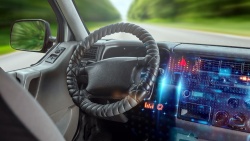Researchers of the Computer Vision Center in Barcelona have created a new virtual world with the aim of teaching autonomous driving vehicles to see and comprehend a city.
Currently, autonomous vehicles -such as the Google Car or Tesla models- need to develop a “core intelligence” which will allow them to identify and recognize visually different elements, such as a road, sidewalks, buildings, pedestrians, etc. In short: to see and understand a road like humans do. The project is promoted by researcher Germán ros along with Dr. Antonio M. López, both from the Computer vision Center in Barcelona.
As Mr. German Ros puts it: “These vehicles need the use of Artificial intelligence (IAs) to understand what is happening around them. This is achieved with the construction of artificial systems which simulate the structure and functioning of human neuronal connections. Our new simulator, SYNTHIA is a huge step forward within this process”.
SYNTHIA (which stands for ‘System of synthetic images’) is able to accelerate and improve the way in which artificial intelligence learn to understand the city and their elements. This is a significant advancement in one of the major challenges within this scientific area. The data generated by the simulator will be delivered openly to the scientific community in Las Vegas in the International Conference on computer Vision and Pattern Recognition. With this, researchers want to trigger the scientific advancement in areas such as artificial intelligence and autonomous driving.
Up till now, the main limitation in the development of artificial intelligence was the big volume of data and human work required for IAs to learn complex visual concepts in diverse conditions (as for example the difference between a road and the sidewalk in a rainy day). A tedious and expensive process which would require a big number of hours of human supervision.
SYNTHIA is therefore a revolution. It makes use of a virtual simulator in order to generate artificial intelligence in a simple and automatic way (with no human intervention). Thanks to this advancement, the typical limitations of human work (time and errors) are left behind making the process much cheaper and opening the door to the development of more sophisticated and secure systems for autonomous driving.
*SYNTHIA: http://synthia-dataset.net/
https://www.youtube.com/watch?v=2t9SFVjZU5M
More info: acanet@cvc.uab.es
93 581 30 73



